Hush Puppies
This post may contain affiliate links. Read my full disclosure policy.
Hush puppies aren’t just a side dish—they’re the star of the meal! These heavenly bites boast a perfectly crunchy exterior, a soft and fluffy interior, and are bursting with rich, corn flavor. Bet you can’t eat just one!
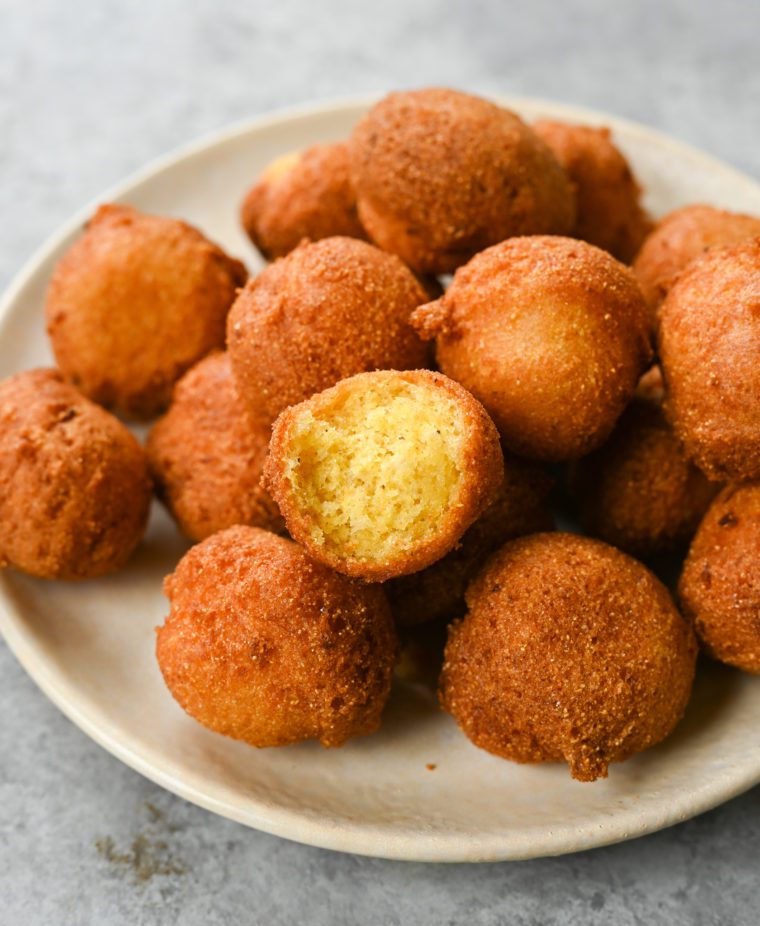
Hush puppies are a beloved Southern dish that pair perfectly with seafood or BBQ. These crispy, bite-sized fritters are made from a cornmeal-based batter, similar to cornbread, that’s deep-fried until golden brown and crispy on the outside and soft and fluffy on the inside. There are many theories about how they got their adorable name, but one popular story suggests that hunters and fishermen would fry up cornmeal batter to “hush the puppies” during cookouts and fish-fries.
When making hush puppies, the right ratio of cornmeal to flour is essential to achieve a light and crispy texture. Too much cornmeal can result in gritty and heavy fritters. I also like to add melted butter for richness, buttermilk for tang, and a hint of Cajun spice to kick up the flavor. Of all the variations I’ve tried and tested, these hush puppies stand out as the absolute best.
Table of Contents
“The hush puppies were delicious! They’re very light and have a lovely flavor.”
What You’ll Need To Make Hush Puppies
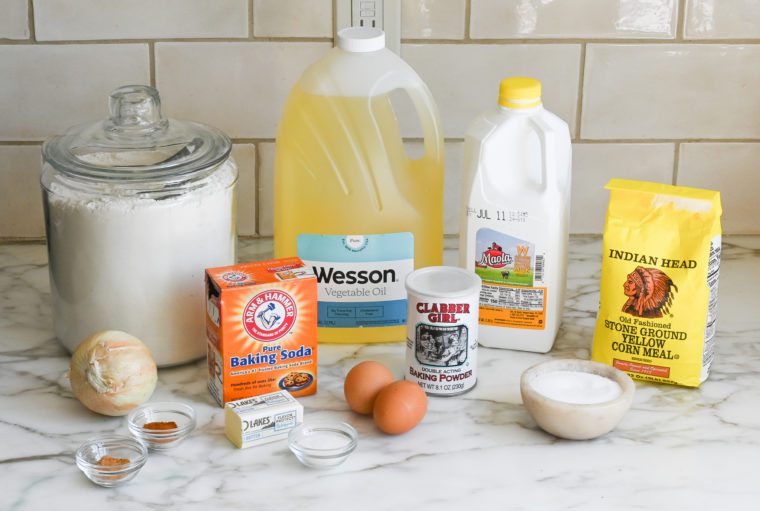
- Cornmeal: Provides the classic slightly gritty texture and subtle corn flavor that is the base of hush puppies.
- All-Purpose Flour: Works in tandem with cornmeal to bind the ingredients, adding structure and a tender crumb to the hush puppies. It not only mitigates the potential grittiness of the cornmeal but also makes the hush puppies fluffier, as usingtoo much cornmeal would make them heavy.
- Baking Powder and Baking Soda: These leavening agents are responsible for making the hush puppies light and airy, ensuring they puff up when fried.
- Cajun Spice and Cayenne Pepper: Add a kick of heat and a depth of flavor, giving the hush puppies a spicy, aromatic profile.
- Buttermilk: Adds moisture and a slight tanginess, contributing to the tender texture and complex flavor of the hush puppies.
- Eggs: Act as a binder, holding the ingredients together, and contribute to the richness and structure of the dough.
- Butter: Incorporates fat for richness and moisture and enhances the the flavor of the hush puppies.
- Grated onion: Provides a subtle sweetness and moisture, adding a layer of savory flavor.
- Oil: Used to deep-frying the hush puppies; the high heat of the oil crisps the exterior while keeping the interior moist and fluffy.
- Jump to the printable recipe for precise measurements
Key Equipment
- A Dutch oven, or enameled cast iron pot, is ideal for frying because it conducts heat evenly and keeps the oil temperature even and consistent. In addition, its high sides prevent splatters, and its light-colored interior allows you to clearly see the color changes when frying.
- A deep-fry/candy thermometer takes all the guesswork out of frying and enables you to maintain the perfect oil temperature throughout the cooking process. (If the oil gets too hot, the outside of the hush puppies will burn before the interior is cooked. Conversely, if the oil gets too cool, the hush puppies will take longer to cook and be greasy.)
- A 1 tablespoon scooper makes for evenly sized hush puppies, and the wire scraper makes quick work of dropping the batter into the oil. (You can also use this scooper for scooping cookie batter.)
Step-by-Step Instructions
In a large bowl, add the cornmeal, flour, baking powder, baking soda, sugar, salt, Cajun spice, and cayenne pepper.
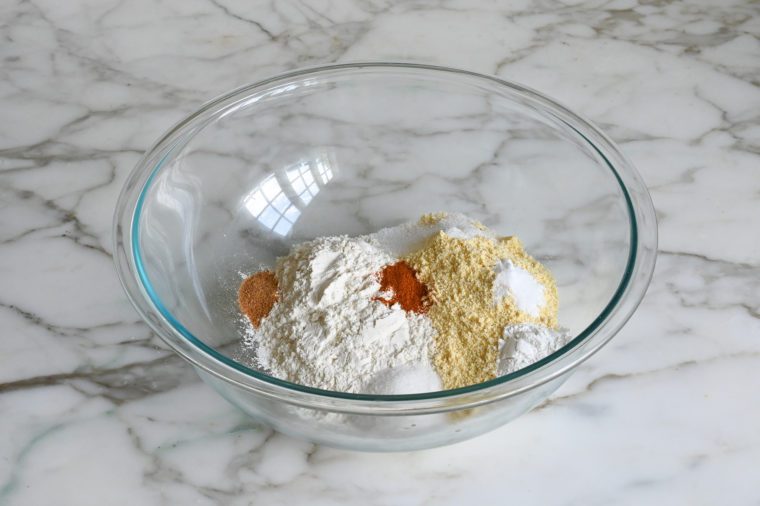
Whisk until combined.
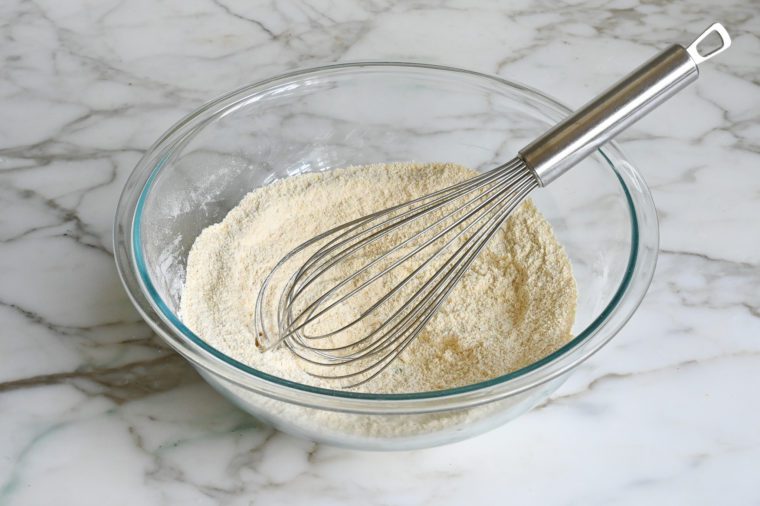
Add the buttermilk, eggs, melted butter, and onion.
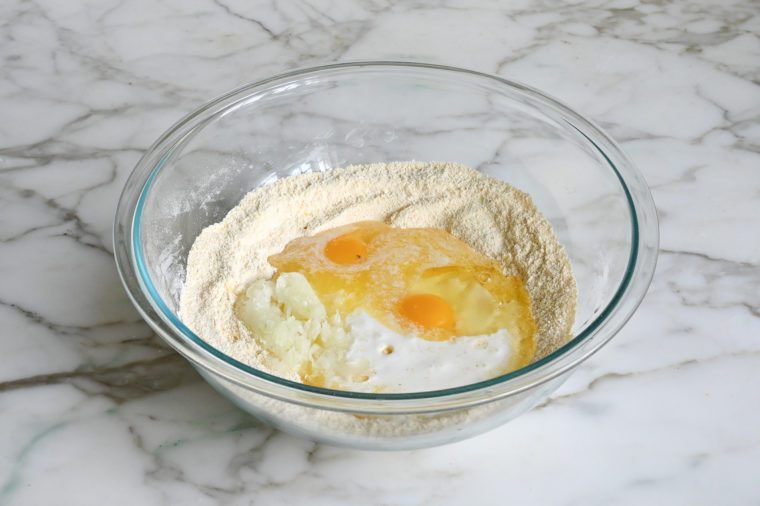
Whisk until evenly combined. Let the batter rest for about 10 minutes to thicken. This allows the batter to thicken up so the fritters hold their shape when fried.
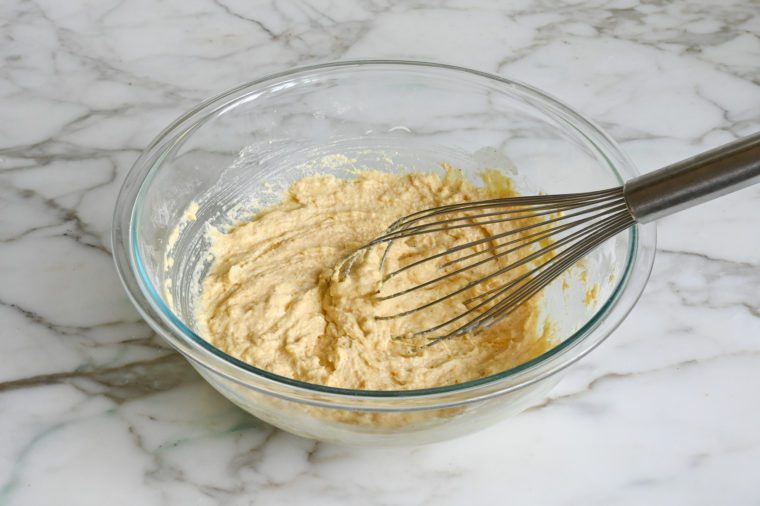
Heat about 2 inches of oil in a large Dutch oven or heavy-bottomed pot over medium-high heat to 350°F. (It’s very helpful to attach a deep-fry/candy thermometer to the pot to monitor the temperature throughout the cooking process, but if you don’t have one, if a cube of bread sizzles when you drop it in the oil, it’s the right temperature.)
Line a baking sheet with paper towels and set next to the stove. When the oil is ready, drop heaping tablespoons of batter into the oil, without crowding.
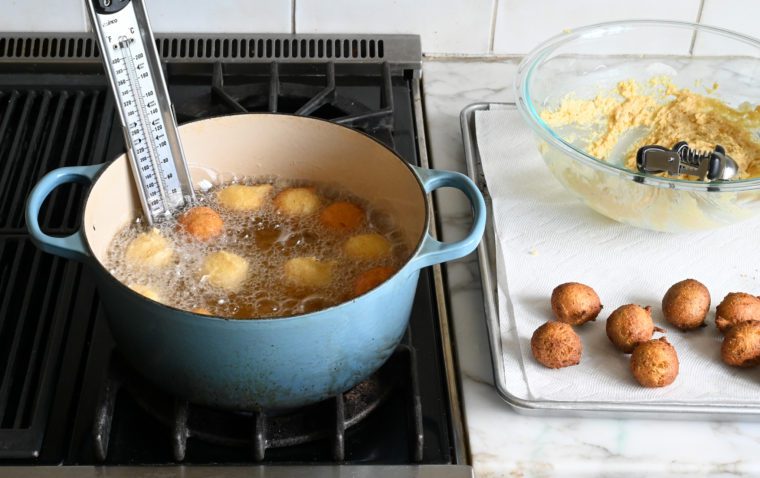
Fry until deep golden brown, 2 to 3 minutes, turning halfway through cooking.
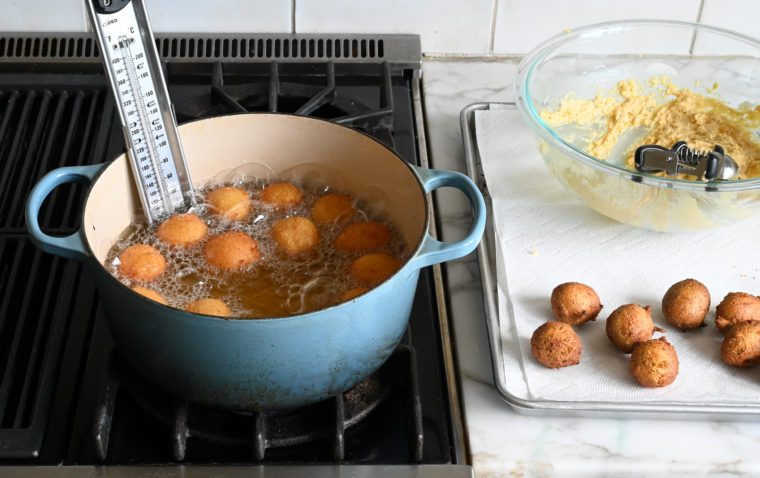
Using a slotted spoon, transfer the hush puppies to the paper towel-lined baking sheet and repeat with the remaining batter. If the hush puppies are browning too quickly, lower the heat; it’s important that the oil maintains a temperature of around 350°F for even cooking.
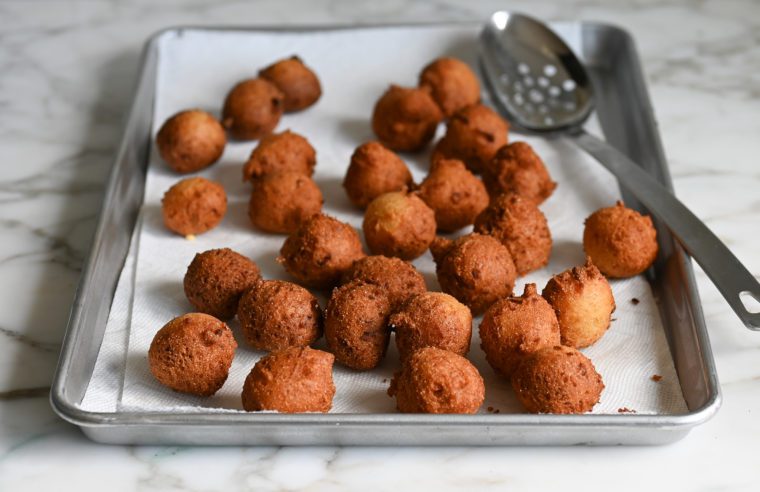
Serve warm. (Leftover hush puppies can be refrigerated in an airtight container for 2 days, or frozen for up to 3 months. Reheat in 350-degree oven for 15 to 20 minutes.)
Frequently Asked Questions
The oil is ready for frying when it reaches a temperature of 350°F to 375°F (177°C to 190°C). If you don’t have a thermometer, you can test the oil by dropping a small amount of batter into it. The batter should sizzle and float to the top without burning. If it burns quickly, the oil is too hot; if it doesn’t sizzle, the oil isn’t hot enough.
Neutral oils with a high smoke point, such as canola, vegetable, or peanut oil, are ideal for frying hush puppies. These oils ensure even frying without imparting additional flavor to the hush puppies.
You do need buttermilk for this recipe, but it’s easy to make your own using milk with lemon juice or white vinegar. See my easy method for how to make buttermilk.
While hush puppies are best enjoyed fresh, leftovers can be refrigerated in an airtight container for up to 2 days or frozen for up to 3 months. To freeze, start by letting the cooked hush puppies cool completely at room temperature. Once cool, arrange them in a single layer on a baking sheet, ensuring they don’t touch, and then place the sheet in the freezer for a few hours until solid. After they’re frozen, transfer the hush puppies to a freezer-safe bag or container, squeezing out as much air as possible, and freeze for up to 3 months. When you’re ready to enjoy them, reheat the hush puppies directly from the freezer in 300°F-oven.

You May Also Like
Hush Puppies
Hush puppies aren’t just a side dish—they’re the star of the meal! These heavenly bites boast a perfectly crunchy exterior, a soft and fluffy interior, and are bursting with rich, corn flavor. Bet you can’t eat just one!
Ingredients
- 1 cup cornmeal
- ¾ cup all-purpose flour
- 1½ teaspoons baking powder
- ¼ teaspoon baking soda
- 1 tablespoon sugar
- 1 teaspoon salt
- ¼ teaspoon Cajun spice
- ¼ teaspoon cayenne pepper
- ¾ cup buttermilk
- 2 large eggs
- 4 tablespoons butter, melted and slightly cooled
- ¼ cup grated yellow onion, from 1 small onion
- About 2 quarts peanut or vegetable oil, for frying
Instructions
- In a large bowl, whisk together the cornmeal, flour, baking powder, baking soda, sugar, salt, Cajun spice, and cayenne pepper. Add the buttermilk, eggs, melted butter, and onion and whisk until evenly combined. Let the batter rest for about 10 minutes to thicken.
- Heat about 2 inches of oil in a large Dutch oven or heavy-bottomed pot over medium-high heat to 350°F. (It's very helpful to attach a deep-fry/candy thermometer to the pot to monitor the temperature throughout the cooking process, but if you don't have one, if a cube of bread sizzles when you drop it in the oil, it's the right temperature.) Line a baking sheet with paper towels and set next to the stove.
- When the oil is ready, drop heaping tablespoons of batter into the oil, without crowding, and fry until deep golden brown, 2 to 3 minutes, turning halfway through cooking. Using a slotted spoon, transfer the hush puppies to the paper towel-lined baking sheet and repeat with the remaining batter. If the hush puppies are browning too quickly, lower the heat; it's important that the oil maintains a temperature of around 350°F for even cooking. Serve warm. (Leftover hush puppies can be refrigerated in an airtight container for 2 days, or frozen for up to 3 months. Reheat in 350-degree oven for 15 to 20 minutes.)
- Note: If you’d like to make your own buttermilk, check out my easy method for how to make buttermilk. (Keep in mind that homemade buttermilk is not as thick as real buttermilk, so I'd suggest using just ⅔ cup to start and adding the remaining 2 tablespoons only if the batter seems too stiff.)
- Make-Ahead/Freezing Instructions: While hush puppies are best enjoyed fresh, leftovers can be refrigerated in an airtight container for up to 2 days or frozen for up to 3 months. To freeze, start by letting the cooked hush puppies cool completely at room temperature. Once cool, arrange them in a single layer on a baking sheet, ensuring they don't touch, and then place the sheet in the freezer for a few hours until solid. After they're frozen, transfer the hush puppies to a freezer-safe bag or container, squeezing out as much air as possible, and freeze for up to 3 months. When you're ready to enjoy them, reheat the hush puppies directly from the freezer in 300°F-oven.
Pair with
Nutrition Information
Powered by ![]()
- Per serving (15 servings)
- Serving size: 2 hush puppies
- Calories: 141
- Fat: 8 g
- Saturated fat: 2 g
- Carbohydrates: 15 g
- Sugar: 2 g
- Fiber: 1 g
- Protein: 3 g
- Sodium: 114 mg
- Cholesterol: 33 mg
This website is written and produced for informational purposes only. I am not a certified nutritionist and the nutritional data on this site has not been evaluated or approved by a nutritionist or the Food and Drug Administration. Nutritional information is offered as a courtesy and should not be construed as a guarantee. The data is calculated through an online nutritional calculator, Edamam.com. Although I do my best to provide accurate nutritional information, these figures should be considered estimates only. Varying factors such as product types or brands purchased, natural fluctuations in fresh produce, and the way ingredients are processed change the effective nutritional information in any given recipe. Furthermore, different online calculators provide different results depending on their own nutrition fact sources and algorithms. To obtain the most accurate nutritional information in a given recipe, you should calculate the nutritional information with the actual ingredients used in your recipe, using your preferred nutrition calculator.

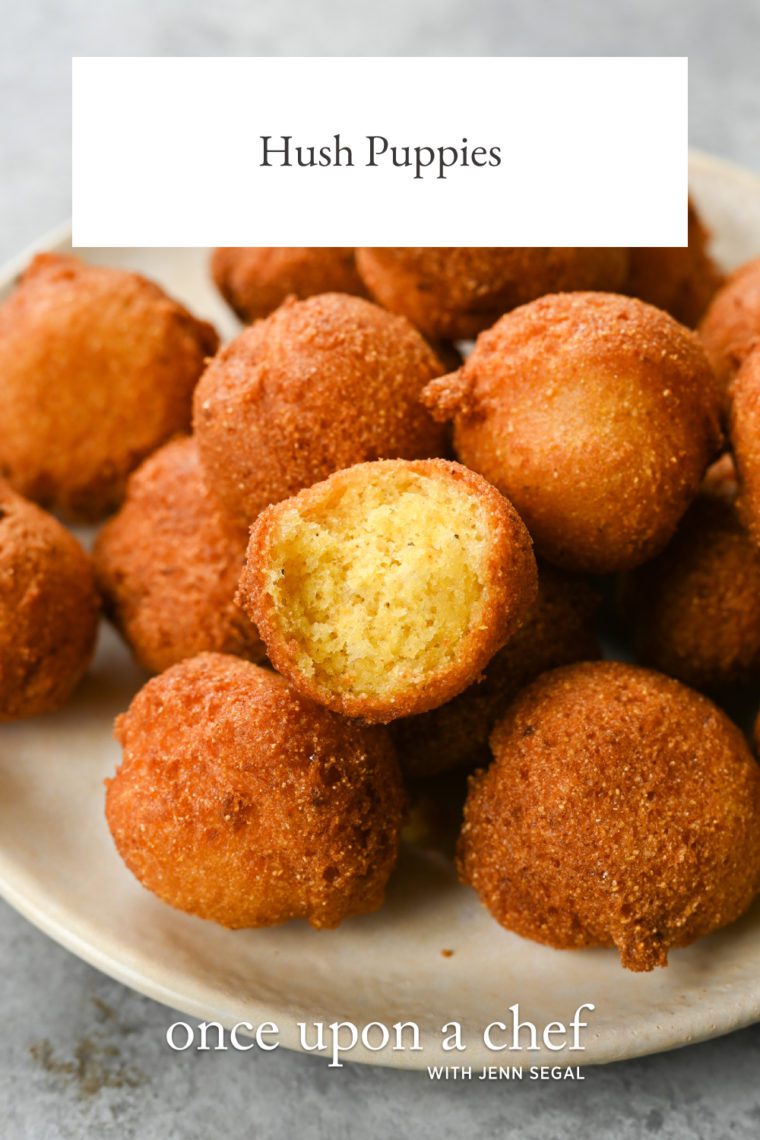
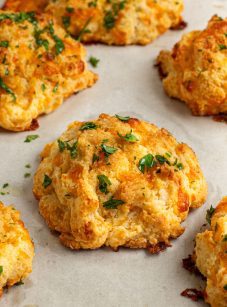
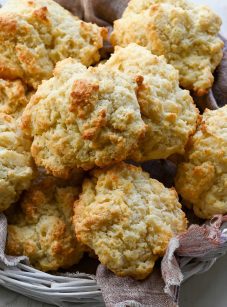


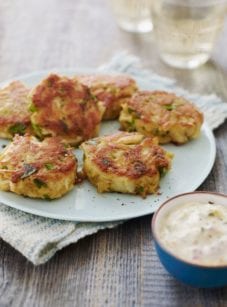
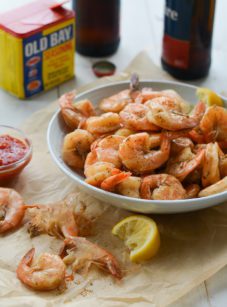
I had high hopes for these. Maybe I made a mistake? Mine were too light and airy. They had air pockets and didn’t look like yours at all. I didn’t have a cookie scoop so I dropped them by spoonfuls. Next time I will try rolling them into balls before adding to the oil.
I made these last night. Followed the recipe precisely. They were perfect!!! Crispy on the outside, fluffy inside. Huge hit at dinner. Thank you 😊
Thank you so much, Jenn. For some reason I have been unable to master hushpuppies until now. Your use of Cajun seasoning and grated onions made all the difference. I did take a bit of a shortcut with my use of Martha White cornmeal mix, but otherwise stayed true to the recipe. Love, love your recipes!!
I first had these a year ago visiting friends in NC with my daughters. They have been begging me ever since to make them. We even purchased King Arthur made to measure gf flour and flew it home to Australia to ensure it would work out the same. So I finally made them this week and we loved them. So much so that I had to make a second batch within days. Thanks so much for your great recipes!
I wonder if you could use an air fryer for these.
Hi Susan, Unfortunately, I don’t think the air fryer will work with these. Sorry!
The hush puppies were delicious! They’re very light and have a lovely flavor. Will definitely make again.
Is it kosher salt or table salt what is called for in the recipe? Also, what brand of Cajun spice? Thanks SO much!!!
Hi Cam, The salt in this recipe is table salt. BTW, when a recipe of mine says salt in the ingredient list, I am referring to regular/table salt. If it calls for something else like kosher salt, I will specify that in the recipe.
And I use Emeril’s Cajun seasoning. Hope that helps and that you enjoy the hush puppies!
I may have written you earlier..
I so appreciate this site!!!
You are clear, in words and pictures.
Thank you
and not charging;-)
💗
Is there a substitute for the flour, so I can make these gluten-free. By the way I am a huge fan of you and all your recipes.
Hi Dena, I think gluten-free flour would work well here. Please LMK how it turns out if you try it. 🙂
I also plan to try with gluten free flour, since one of our kids has a gluten allergy. It’s been my (limited) experience that certain quick breads like cornbread, banana bread, pumpkin bread, etc. work pretty well with a one-for-one gluten free flour blend. It’s harder for me to taste the substitution in those. I used gluten free flour in Jen’s banana bread recipe and it worked very well. I’ve never fried any kind of dough before, never mind a gluten free dough, so it will be an interesting experiment. If it doesn’t turn out I’d never fault the recipe because it wasn’t developed with gluten free flour. I’m sure it’s awesome as written; everything I’ve made from this site has been excellent. Looking forward to trying this out!
Update: I made this tonight using the King Arthur Measure for Measure Gluten Free Flour Blend. The hush puppies turned out beautifully. (Full disclosure – I also left out the cayenne pepper. The child who has the gluten allergy tends to complain when foods are “too spicy”, and I wanted to increase my chances of her liking this.) Victory! She enjoyed the one I gave her to try and asked for more. I liked them, too; I was so pleased at how nice they looked and tasted. But really, the best part was seeing how excited my daughter was at getting to try this food for the first time. She’s only four, but she knows the drill; the few times we’ve ever had hush puppies from a barbeque joint, she couldn’t have them because they weren’t gluten-free. Thank you, Jen, for a great recipe, and for helping me make an even better memory tonight!
I would love to know as well. Gluten free at our home, too.
I’ve always hesitated from frying. What do you do with the oil after you are done? How do you dispose of it? Can you reuse it?
Hi Caroline, Here are some guidelines for what to do with the oil after you’ve used it to cook. Hope that helps!
Thank you so much for the link on how to handle used frying oil. I too have refrained from deep frying because no one ever did it in my family, and I don’t know how to. These instructions are clear and concise. I have my Le Creuset pot at the ready, and just received my deep fry thermometer from Amazon. Cannot wait to make the hush puppies (the frozen store bought variety just are not great)!!!